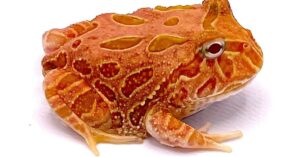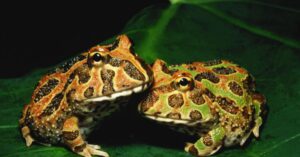🐸 Pacman Frogs vs. Tree Frogs: Key Differences
Which Frog Is the Best Fit for You?
Pacman Frogs vs. Tree Frogs - At a Glance
Pacman frogs are ground-dwelling, wide-bodied ambush predators, while tree frogs are slim, arboreal climbers. Pacman frogs prefer minimal handling and a moist substrate, whereas tree frogs need vertical space, branches, and more humidity control. Each species suits a different kind of keeper and habitat setup.
Choosing your first (or next) amphibian? Two of the most popular pet frogs are Pacman frogs (Ceratophrys spp.) and tree frogs (various genera like Hyla, Litoria, and Agalychnis). While both are captivating creatures, they couldn’t be more different in behavior, care, and habitat needs.
In this article, you’ll learn:
Physical and behavioral differences
Tank setup and care requirements
Feeding styles and activity levels
Handling tolerance and temperament
Which frog may be the better choice for your lifestyle
Physical Differences
| Feature | Pacman Frogs | Tree Frogs |
|---|---|---|
| Body shape | Round, wide, squat | Slim, long-legged, athletic |
| Size | 4–7 inches (females larger) | 1–4 inches depending on species |
| Leg structure | Short, muscular hind limbs for lunging | Long limbs for climbing |
| Eyes | Forward-facing, buried in head | Prominent, wide-set eyes |
| Coloration | Often green, brown, red, or albino morphs | Wide range, including bright neon colors |
👉 Pacman Frog Morphs: Color Variants and Genetics
👉 Pacman Frog Growth Stages Explained
Habitat and Enclosure Needs
| Feature | Pacman Frogs | Tree Frogs |
|---|---|---|
| Tank style | Horizontal 10–20 gallon, floor-focused | Vertical 18x18x24 enclosure, height-focused |
| Substrate | Moist coco fiber or sphagnum moss | Moist substrate with climbing features |
| Humidity | 70–80% | 60–80%, often more misting needed |
| Decor | Hides, leaf litter, low décor | Branches, vines, leaves, suction-cup décor |
| Lighting | Low to moderate lighting | Often require low-level UVB for skin health |
👉 Pacman Frog Tank Setup for Beginners
👉 Best Substrate for Pacman Frogs
Feeding Behavior and Diet
| Behavior | Pacman Frogs | Tree Frogs |
|---|---|---|
| Feeding style | Sit-and-wait ambush predator | Active insect chaser |
| Diet | Insects, worms, pinkies, small lizards | Crickets, roaches, moths, fruit flies |
| Feeding frequency | 2–3x weekly as adults | Small meals every 2–3 days |
| Feeding aggression | Very aggressive, may bite | Delicate, more gentle feeders |
👉 What Do Pacman Frogs Eat? Complete Feeding Guide
👉 How Often Should You Feed a Pacman Frog?
Temperament and Handling
| Trait | Pacman Frogs | Tree Frogs |
|---|---|---|
| Handling tolerance | Very low—only for emergencies | Moderate—can be handled gently and briefly |
| Aggression | Defensive, may lunge or bite if provoked | Timid but rarely aggressive |
| Vocalization | Loud croaks, especially males | Chirps and peeps at night |
| Activity level | Very sedentary, hides most of the time | More active and exploratory, especially at night |
👉 Handling Pacman Frogs: Should You or Shouldn’t You?
👉 Do Pacman Frogs Croak? Understanding Their Sounds
Which Frog Is Best for You?
| Category | Best Choice |
|---|---|
| Low-maintenance care | Pacman Frog |
| Visual display pet | Tree Frog |
| Beginner-friendly | Either, with proper research |
| Minimal handling | Pacman Frog |
| Interactive behavior | Tree Frog |
| Space-saving setup | Pacman Frog |
| Humidity control practice | Tree Frog |
FAQ: Pacman Frogs vs. Tree Frogs
Q: Can I keep a Pacman frog and a tree frog together?
A: Absolutely not. They have different environmental needs, and Pacman frogs may eat smaller frogs.
Q: Which frog is easier for kids to care for?
A: Pacman frogs are more hands-off and easier to maintain, but should never be handled by young kids.
Q: Do either species need UVB lighting?
A: Tree frogs benefit from low-level UVB. Pacman frogs can thrive without it if their diet is properly supplemented.
Final Thoughts
While both Pacman frogs and tree frogs are captivating additions to any amphibian enthusiast’s collection, their needs and behaviors couldn’t be more different. Whether you prefer a ground-dwelling, ambush predator or a nimble climber with nighttime activity, understanding these key differences ensures your frog thrives in your care.




